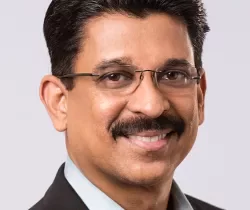One interesting characteristic of virtual and hybrid events is that virtual (or digital) attendees can significantly outnumber those on-site. For example, February’s MWC Shanghai registered 25,000 attendees on-site and close to 125,000 virtually.
At large hybrid events, meetings and networking are key objectives for attendees whose business depends on making critical business relationships and decisions. Whether they’re participating in-person or remotely, attendees want to see the latest technologies and products and learn how they can apply them in their businesses.
Similarly, exhibitors want to connect with these attendees, who are either existing customers or prospects, and help them with that decision. For event marketers who manage their brand’s presence at a hybrid event, the question is how to design a presence that engages optimally with both in-person and remote attendees in order to establish meaningful dialogue with key prospects and customers — and drive business opportunities.
The first step is to define specific event objectives. Will the focus be a product launch, or to showcase a new partnership? Are we looking to build awareness for innovations in an existing technology, or take orders for a new service? The answers to these questions from your sales, product, leadership and other teams will shape our communications strategy.
Next, define the time period over which you want to connect and engage with prospects and customers. For example, while the in-person component of a hybrid event may run three to four days, think in terms of extending interactions with prospects and customers well beyond the event.
Also, think globally. Keep in mind that there will be remote attendees participating from numerous time zones, so your organization will meet more of these people if you can let them schedule a time that works best for them — before, during and after the event.
In the weeks leading up to your next hybrid event, the following five audience engagement strategies will maximize your ROI by increasing the number of valuable customer and target prospect engagements. To scale up your potential, consider using a robust meeting automation platform; this will simplify the process of scheduling, managing and also reporting on the many prospect and customer engagements you’re aiming to book.
1. Set up your inbound meeting mechanism
Ideally, you should funnel all your event attendees to a central web location where they choose where and when to meet. Perhaps they want to meet at the booth for a demo, meet their sales rep or book a meeting with your industry or product expert. By creating an “inbound meeting request page” that automatically offers available time slots, you can make it easy for prospects to book that meeting while the idea is top of mind. Your system should include a vetting and approval process, and automate calendar invites and video-conferencing information for meeting attendees.
2. Build momentum by pre-scheduling
You want to maximize the number of meetings associated with the event, so 6-8 weeks out, integrate links and buttons into all your digital marketing programs. These links should enable your prospects and customers to book specific activities, such as register for a session, sign up for a demo, book a meeting, meet the expert and so on. Meanwhile, your sales team should schedule meetings with customers and prospects based on opportunity data, previous discussions and other indicators.
3. Focus on scheduling demo meetings
At any major industry hybrid event, in-person attendees can easily walk up to a booth and schedule a demo. Over in virtual event land, we can also schedule demos. To book more demos with qualified prospects, define a variety of demo types that are optimized for specific lead categories. You can then map these demos to different topics, products or services and presenters — for both in-person and virtual attendees. Then, promote these demos in your outbound activities so that attendees can self-book while you capture details to pre-qualify them and ensure the right team members attend.
4. Integrate tracks and sessions into the meeting mix
For most B2B brands, events are an opportunity to educate prospects and customers. Tracks and sessions are part of most hybrid events, and these can easily be extended for your remote attendees. Integrate these into your pre-event promotions, and don’t forget to invite your sales team to nominate their top prospects and customers. Again, consider how you might extend the availability of these sessions months after the event.
5. Offer “Meet the Expert” and “Meet the Executive” opportunities
Some prospects and customers may want to get the information they need from someone other than a salesperson. Here’s where the “Meet the Expert” or an exclusive “Meet the Executive” program for VIP customers plays a vital role by making your internal industry, product or department experts available for scheduling. This program can be added to your inbound meeting request page and then completely automated. We saw one customer schedule hundreds of MTE meetings surrounding a week-long customer event: all virtual, all completely automated.
In some ways, hybrid events offer the best of both worlds. Whether it’s an in-person meeting onsite or a virtual meeting in the weeks that follow, there are hundreds of ways to engage prospects and customers so you can educate, boost consideration and build your sales pipeline and revenue potential. The trick is to provide as many pathways and opportunities as possible for key prospects and customers to self-book and define their own buyer journey. If you can also automate the entire meeting set-up and follow-up process, you’ll be well on your way to maximizing the ROI of your virtual, hybrid and in-person events this year.



Add new comment